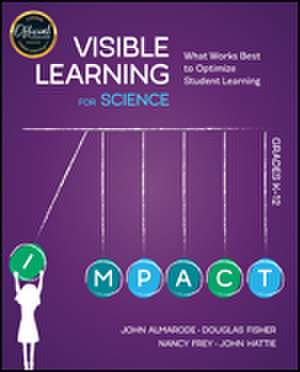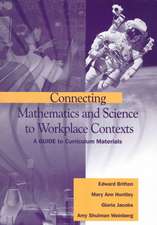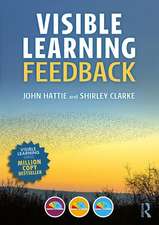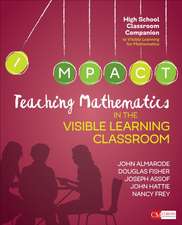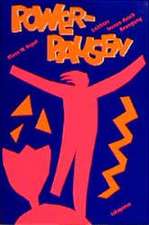Visible Learning for Science, Grades K-12: What Works Best to Optimize Student Learning
Autor John T. Almarode, Douglas Fisher, Nancy Frey, John Hattieen Limba Engleză Paperback – 17 iun 2018
Preț: 291.05 lei
Nou
Puncte Express: 437
Preț estimativ în valută:
55.70€ • 60.48$ • 46.79£
55.70€ • 60.48$ • 46.79£
Carte disponibilă
Livrare economică 01-15 aprilie
Livrare express 18-22 martie pentru 34.17 lei
Preluare comenzi: 021 569.72.76
Specificații
ISBN-13: 9781506394183
ISBN-10: 1506394183
Pagini: 216
Dimensiuni: 187 x 232 x 12 mm
Greutate: 0.43 kg
Ediția:1
Editura: SAGE Publications
Colecția Corwin
Locul publicării:Thousand Oaks, United States
ISBN-10: 1506394183
Pagini: 216
Dimensiuni: 187 x 232 x 12 mm
Greutate: 0.43 kg
Ediția:1
Editura: SAGE Publications
Colecția Corwin
Locul publicării:Thousand Oaks, United States
Recenzii
“The authors have written a book with research to support that various learning techniques are effective at different times. Its lack of ‘an all or nothing’ approach truly impresses. This book reminds teachers to make relevance obvious when teaching science standards and that mistakes are necessary for learning to occur. It is so relevant in today’s school climate and is an easy read for busy teachers who are trying to do the best they can for their students.”
“Visible Learning for Science is a great science methods text with its many, many great examples and excellent inclusion of research. I would definitely use this book in the classroom!”
“Visible Learning for Science is a great science methods text with its many, many great examples and excellent inclusion of research. I would definitely use this book in the classroom!”
Cuprins
List of Videos
Acknowledgments
About the Authors
Introduction
Chapter 1. Science Learning Made Visible
Visible Learning
Surface, Deep, and Transfer
Challenging Tasks
Science Is More Than Demonstrations and Labs
The Role of Social Skills in Science
Teacher Clarity
Conclusion
Reflection Questions
Chapter 2. Science Surface Learning Made Visible
Surface Learning in Science
Selecting Science Tasks That Promote Surface Learning
Surface Learning in Science Made Visible
Scientific Processes and Thinking
Feedback
Conclusion
Reflection Questions
Chapter 3. Science Deep Learning Made Visible
Deep Learning in Science
Selecting Science Tasks That Promote Deep Learning
Deep Learning in Science Made Visible
Scientific Processes and Thinking
Feedback
Conclusion
Reflection Questions
Chapter 4. Science Transfer Learning Made Visible
Transfer Learning
Types of Transfer: Near and Far
The Paths for Transfer: Low-Road Hugging and High-Road Bridging
Managing Misconceptions
Conditions Necessary for Transfer Learning
Selecting Science Tasks That Promote Transfer Learning
Helping Students Transform Scientific Understanding
Scientific Processes and Thinking
Feedback
Conclusion
Reflection Questions
Chapter 5. Science Learning Made Visible Through Evaluation
Determining Impact
Calculating the Effect Size
Selecting Evaluations That Promote
Response to Intervention in the Science Classroom
Learning From What Doesn’t Work
Conclusion
Reflection Questions
References
Index
Acknowledgments
About the Authors
Introduction
Chapter 1. Science Learning Made Visible
Visible Learning
Surface, Deep, and Transfer
Challenging Tasks
Science Is More Than Demonstrations and Labs
The Role of Social Skills in Science
Teacher Clarity
Conclusion
Reflection Questions
Chapter 2. Science Surface Learning Made Visible
Surface Learning in Science
Selecting Science Tasks That Promote Surface Learning
Surface Learning in Science Made Visible
Scientific Processes and Thinking
Feedback
Conclusion
Reflection Questions
Chapter 3. Science Deep Learning Made Visible
Deep Learning in Science
Selecting Science Tasks That Promote Deep Learning
Deep Learning in Science Made Visible
Scientific Processes and Thinking
Feedback
Conclusion
Reflection Questions
Chapter 4. Science Transfer Learning Made Visible
Transfer Learning
Types of Transfer: Near and Far
The Paths for Transfer: Low-Road Hugging and High-Road Bridging
Managing Misconceptions
Conditions Necessary for Transfer Learning
Selecting Science Tasks That Promote Transfer Learning
Helping Students Transform Scientific Understanding
Scientific Processes and Thinking
Feedback
Conclusion
Reflection Questions
Chapter 5. Science Learning Made Visible Through Evaluation
Determining Impact
Calculating the Effect Size
Selecting Evaluations That Promote
Response to Intervention in the Science Classroom
Learning From What Doesn’t Work
Conclusion
Reflection Questions
References
Index
Notă biografică
Dr. John Almarodeis a bestselling author and an Associate Professor of Education at James Madison University. He was awarded the inaugural Sarah Miller Luck Endowed Professorship in 2015 and received an Outstanding Faculty Award from the State Council for Higher Education in Virginia in 2021. Before his academic career, John started as a mathematics and science teacher in Augusta County, Virginia. As an author, John has written multiple educational books focusing on science and mathematics, and he has co-created a new framework for developing, implementing, and sustaining professional learning communities called PLC+. Dr. Almarode¿s work has been presented to the US Congress, the Virginia Senate, and the US Department of Education. One of his recent projects includes developing the Distance Learning Playbook for College and University Instruction in response to the COVID-19 pandemic.
Continuing his collaborative work with colleagues on what works best in teaching and learning,How Tutoring Works,Visible Learning in Early Childhood,andHow Learning Works, all with Corwin Press, were released in 2021.
Descriere
This book guides teachers to the right instructional approach to use at each learning phase so all students demonstrate more than a year's worth of science learning per school year.
